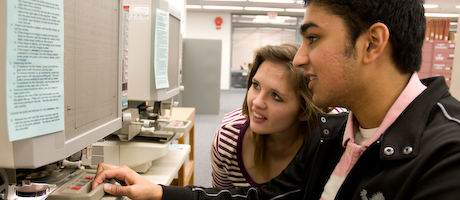What would it take to mobilize Americans around the issue of climate change on a scale comparable to World War II?
Al Gore points to the need for a wartime effort in An Inconvenient Truth. Thomas Friedman does the same in Hot, Flat, and Crowded. So during one week in September, students in Assistant Professor Michael Svoboda’s UW20 classes poured over past and present issues of ten magazines to compare their coverage of World War II with that of the current climate crisis—one indicator of how the issues dominate their respective times.
Using resources from GW’s Gelman and Eckles libraries, the students combed through microfiche, archival volumes, and current periodicals to record the percentage of WWII and climate change content in the 1942 and 2008-09 issues, respectively, of American Scholar, Atlantic, Foreign Affairs, Harper’s, Nation, National Geographic, The New Republic, Newsweek, Science and Time.
The students documented their observations in a series of reports they wrote for the Class of 2013 Freshman Reading Program blog edited by Eckles Librarian Robin Delaloye. The first of those reports was published on Veterans Day.
Not surprisingly, coverage of World War II dominated most of the 1942 issues—as much as 87 percent of the content in Time, The New Republic and Foreign Affairs, for example, was devoted to the war—but the results for climate change were surprising. “On the whole, less coverage was given to climate change in current issues than we expected, typically by a factor of 10 and sometimes close to 20,” says Dr. Svoboda. “In terms of the amount of time the public is hearing about it, reading about it, seeing it—we found we’re nowhere close to a World-War II-scale effort.”
“I thought it was an interesting analogy to look at global warming from the perspective of World War II,” says freshman Caitlin Souders, who worked with classmates Nirav Patel and Timothy Rennie in an analysis of Time in microfiche and hard copy. “I’ve never thought about it that way but it shows the difference in the coverage, and it’s quite shocking.”
“It’s interesting to see that global warming is nowhere near as important in the public mind as the war was,” adds Mr. Patel. “We need that kind of effort right now, because if we don’t, we won’t have any impact.”
Dr. Svoboda says he and Eckles Library Manager John Danneker developed the exercise not only to address the issue of climate change coverage but also to provide students with a “broader understanding of research.” “There are multiple ways to approach a topic and different methods of analysis,” said Dr. Svoboda. “This was one way to get students to do original research in a condensed time period. I’m hoping people pay attention to the results because I don’t think anyone has generated this kind of data before.”
“It was an interesting exercise in historical research,” says Mr. Danneker, who helped locate resources for the project. “And it reminded students that if you need to work with materials that aren’t available digitally, you can always go back to the physical artifact.”
Although the results show that concern over climate change is hardly comparable to the attention given World War II, Dr. Svoboda says the students gained valuable insight into research and editing processes. “We had one discussion when I brought in World War II ads and posters, and we talked about what we had seen and what it meant. Those were some of the best class discussions I’ve had,” he says. “I think this study enabled the students to look at our contemporary culture differently and I was very pleased with the results.”


